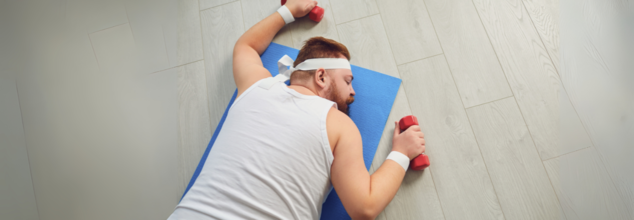- Health Conditions A-Z
- Health & Wellness
- Nutrition
- Fitness
- Health News
- Ayurveda
- Videos
- Medicine A-Z
- Parenting
- Web Stories

(Credit-Canva)
Stop Exercising Immediately If You Notice These Signs
Exercising is a great habit one should adopt. Not only does it help people better their health, but it also help them gain self-confidence, better mental health etc. World Health Organization (WHO) statistics show that people who are inactive often face 20% to 30% increased risk of death compared to people who are regularly active. This doesn’t mean one must spend long hours exercising, the American Heart Association recommends 150 minutes of moderate-intensity exercise per week, and for vigorous intensity exercise, it is 75 minutes per week.
So, how can something that improves the quality of our lives be so detrimental that we must stop doing it?
You Could Be Overdoing Your Exercises
While exercising is very good for your body, if not done right it can injure you. There are many factors one must consider when it comes to exercising.
it's crucial to recognize that there's a limit to how much exercise is beneficial. MedlinePlus exceeding this limit can lead to overtraining and adverse effects. Experts explain early signs of overtraining include a decline in progress or results, persistent fatigue, muscle soreness, and sleep disturbances. These symptoms indicate that the body is under excessive stress.
Despite all the benefits of exercising, there are times when you must stop exercising. Here are some signs of overtraining according to the National Academy of Sports Management.
Elevated Heart Rate That Doesn't Decrease With Rest
Watch your heart rate during workouts. If your heart stays high or beats unevenly when you rest, stop exercising. A heart rate that doesn't slow down means your body is stressed, and you should stop and rest.
Sudden Shortness of Breath
Know the difference between normal exercise breathing and unusual shortness of breath. If you suddenly can't breathe during an easy activity, stop. Sudden breathlessness can indicate a problem. See a doctor if it happens.
Dizziness
Feeling dizzy while exercising could mean you're pushing too hard or dehydrated. If dizziness continues after resting and drinking water, or if you feel confused or faint, get medical help. Dizziness is a sign to stop and check what's wrong.
Leg Cramps
Leg cramps during exercise might signal circulation problems or dehydration. Cramps can also be caused by low electrolytes. To relieve cramps, cool the area, stretch, and massage the muscle. If cramps are frequent, consult your doctor.
Irregular Heartbeat
If you have irregular heartbeats, like atrial fibrillation, pay close attention to your heart. If you feel fluttering or thumping in your chest, seek emergency medical care. Irregular heartbeats can be dangerous and require immediate attention.
Sudden Increase in Sweat Levels
An unexpected increase in sweating during a normal workout could mean your body is stressed. If you sweat a lot more than usual, especially when it's not hot, stop exercising. Excessive sweating can be a warning sign, so take a break and see if something is wrong.
Another Sign You Shouldn’t Ignore
Chest pain during exercise is not normal. If you feel pain or pressure in your chest, especially with nausea, dizziness, or heavy sweating, stop immediately. Chest pain can signal a serious problem, so seek medical help right away.
Safety Precautions With Exercising
Don't jump from no exercise to hard workouts. Slowly increase how long and how intense you exercise. Give your body time to adjust. Take breaks and don't push too hard too fast. Returning to exercise should be a gradual process. People who are at risk for heart disease, including those with hypertension, high cholesterol, diabetes, a history of smoking, or a family history of heart disease, should consult their doctor before starting an exercise program.

(Credit-Canva)
Simple Yet Effective Yoga Pose That You Can Help You Focus On Your Work
One of the biggest benefits of yoga is its effectiveness to relieve stress and help you focus on your current self of well-being. While you may think yoga needs to be done in a certain place at a certain dedicated time, most yoga poses do not need extra bells and whistles. All you need is the right yoga pose. One such yoga pose that you can do anywhere and anytime is Padmasana. It may look similar to sitting cross-legged, but there are slight differences between them.
Also known as the Lotus pose, it is a pose that symbolises peace and resilience. While you can definitely practice this at home, if you have a comfortable work chair you can practice this a well. While it may be a bit difficult to sustain this pose, you will notice many differences in your body after a while of doing it.
Benefits of Padmasana
Regular practice of Padmasana offers several physical benefits. It provides a beneficial stretch to the muscles of the thighs, calves, ankles, and hips. Additionally, it can help in correcting minor irregularities in the spinal alignment and positively affect the pelvic region and the lower abdomen.
Beyond the physical stretch, Padmasana offers therapeutic advantages. By encouraging an erect spine it helps to correct posture. It also enhances flexibility in the lower extremities, specifically stretching the ankle and knee joints. Furthermore, it can improve blood circulation in the abdominal area and may be helpful in managing menstrual discomfort and sciatica issues.
What Else Does It Help You With?
Beyond the physical stretch, Padmasana offers therapeutic advantages. By encouraging an erect spine, it helps to correct posture. It also enhances flexibility in the lower extremities, specifically stretching the ankle and knee joints. Furthermore, it can improve blood circulation in the abdominal area and may be helpful in managing menstrual discomfort and sciatica issues.
The practice of Padmasana involves several muscle groups working together. These include the hip abductors, flexors, and medial rotators in the hips. The pose also engages the muscles around the knees and elbows, as well as the ankle plantar flexors in the ankles.
How to Do Padmasana
- Gently bend your right leg at the knee. Carefully fold it inwards and place your right heel on top of your left thigh. The sole of your right foot should be facing upwards.
- Now, bend your left leg at the knee and fold it. Bring your left heel on top of your right thigh, aiming to cross your ankles. Ideally, your heels should be positioned as closely together as is comfortable.
- Try to gently press both of your knees down towards the ground as much as feels natural and safe.
- Maintain an upright posture with your head, neck, and torso aligned in a straight line. Gently draw your abdomen inwards to support your spine.
- Place your left hand below your navel, with the palm facing upwards. Rest your right hand on top of your left hand, also with the palm facing upwards. Allow your shoulders and hands to relax.
- Remain in this pose, focusing on your natural breath or gently directing your gaze towards a chosen point.
- Gently release your hand position, allowing them to rest comfortably on your knees or thighs.
- Slowly and carefully lift the leg that is on top with the support of your hands and place it back down on the mat. Then, gently unfold your other leg.
- Finally, slowly straighten both of your legs back to the initial stretched-out position.

(Credit-Canva)
These Yoga Asanas Can Help You Grow Taller At Any Age
Seeing kids grow up is a rewarding feat for parents. The kids who used to be no taller than your legs seem to grow up too soon. While kids are biologically bound to grow taller, many factors can affect it. We are often reprimanded for slouching and sitting in a bad posture, however these often fell on deaf ears. However, these are very important factors to consider, not just for height, but also for your back health.
Many times, your posture prevents you from reaching your true height potential. When you slouch and compress your spine for long, you are bound to shorten your height. The Cleveland clinic explains that doing yoga can help you strengthen your posture and express your height properly.
For children, exercise plays a big role in their height growth. Other factors include what kind of food they eat and their lifestyle choices. Certain yoga poses are believed to stretch the body in ways that can potentially stimulate growth hormone production and improve posture, contributing to a taller appearance. Additionally, yoga is known for its relaxing properties, helping to alleviate emotional and mental stress, which can indirectly support overall well-being. Here are some you should try.
Yoga Asanas Children Should Do To Grow Taller
It is important to note that all the yoga postures (asanas) and breathing exercises (pranayama) described below should be practiced under the careful supervision of a certified yoga instructor. They can provide personalized guidance, ensure correct alignment, and help you avoid potential injuries.
Tadasana (Mountain Pose)
This standing pose stretches the whole body, from your feet to your fingertips. This lengthening action feels good and is thought to encourage the body to produce more growth hormones. Stand tall with feet together, raise arms overhead while inhaling, lift onto your toes, stretch upwards, and then gently come back down.
Bhujangasana (Cobra Pose)
Lying on your stomach, this pose stretches your lower and upper back, along with your abdominal muscles. It can also help reduce fat around your waist. By lifting your upper body using your arms while keeping your lower body grounded, you lengthen your spine, which is beneficial for increasing height.
Paschimottanasana (Seated Forward Bend)
Sitting with legs straight out, bend forward from your hips, reaching for your toes. This stretches your hamstrings and spine. Practicing on an empty stomach, ideally in the morning, is recommended. Besides stretching, it's believed to aid digestion and stimulate organs involved in growth.
Vrikshasana (Tree Pose)
Standing on one leg with the other foot placed on your inner thigh, raise your arms overhead with palms together. This balancing pose is thought to stimulate the pituitary gland, which is key in producing growth hormone. Hold the pose steadily, focusing on balance and a gentle neck stretch.
Trikonasana (Triangle Pose)
Standing with feet wide apart, bend sideways, reaching one hand towards your foot while extending the other upwards. This pose strengthens your legs and core, stretches your hips and hamstrings, and helps align your spine. Proper spinal alignment can contribute to a taller and more upright posture.

Credits: Canva
Is Running Enough For Leg Day Workout?
When you're a consistent runner, it feels like it's leg day, every day. Your quads, glutes, hamstrings, and calves are working hard — taking you up steep inclines, powering you through speed intervals, and carrying you to the finish line. So you naturally want to know: if you're running regularly, do you no longer need to do lower-body strength training?
The quick answer, not exactly. While running definitely makes your legs stronger in certain ways, it doesn't entirely substitute for the special benefits that result from traditional strength training. Here's what you need to know about how running develops strength, why strength training is still important, and how to strategically balance both for peak performance and injury prevention.
How Running Strengthens Your Muscles?
Running creates a specific kind of strength called strength endurance. This is the ability of your muscles to produce force repeatedly over a long time. Each time you take a step, there's repetitive muscle contraction building you up for sustained effort, much like performing a high-rep, low-weight exercise. Rather than lifting dumbbells, you're lifting your own body weight step after step.
In addition, running — especially when involving hill sprints, speed intervals, and strides — can create a bit of explosive strength, or the capacity to produce a large amount of force in a short time. If your runs, however, consist primarily of steady paces on flat surfaces, you won't be tapping into this kind of strength.
What running does not effectively build up is maximal strength — your capacity to generate the most force during one effort. Maximal strength training generally demands that you lift heavy weights for few repetitions, a stimulus running by itself just cannot offer, regardless of distance or speed.
Why Strength Training Still Matters for Runners?
Developing various kinds of strength depends on the idea of progressive overload: progressively putting more demands on your muscles by using heavier loads, more repetitions, less rest, or harder movements. Although running can incorporate some progressive overload — say, by adding mileage or hill sprints — there's a real-world and biological limit to how much you can push this.
Amplifying run volume significantly heightens your vulnerability to overuse injuries. Higher increases in training load were also associated with a greater incidence of injury among runners training for the New York City Marathon, a 2022 British Journal of Sports Medicine found. Not every athlete can or should go from 30 to 60 miles per week attempting to add greater strength — too often, risk just isn't worth the potential reward for many athletes.
Conversely, traditional resistance training provides a safer, more targeted, and more effective means of gradually increasing your muscle overload. Through lifting heavier weights, varying rest times, experimenting with tempo, and doing compound exercises such as squats, lunges, and deadlifts, runners can enhance maximal strength without having to significantly boost their mileage.
This additional strength translates back into your running: stronger muscles mean greater running efficiency, better injury resilience, and the ability to maintain good form even when fatigue sets in during longer distances.
Finding the Right Balance Between Running and Strength Training
If you’re wondering how to fit strength work into your running routine without feeling perpetually sore or exhausted, the key lies in smart scheduling and recovery.
Begin with strength training once or twice a week, preferably on hard run days to make your easy days really easy. Focus on full-body strength sessions, but pay particular attention to the lower body, core, and posterior chain (glutes, hamstrings, back). Most importantly, prioritize proper form and controlled movements over lifting as heavy as possible from the start.
Let your body adjust slowly. Sure, you may be a bit sore initially — especially if you haven't been doing much strength training — but eventually, your body will learn to cope with the increased stimulus. In the long term, the reward in enhanced running performance and decreased risk of injury is well worth the initial investment.
Is Running by Yourself Leg Day?
While running does develop muscular endurance and some explosive power, it doesn’t provide the maximal strength benefits that structured resistance training delivers. Therefore, if you’re serious about being a stronger, faster, and healthier runner, running alone shouldn’t be your only form of leg training.
Consider running and strength training as two pieces of a larger, holistic fitness puzzle. Both play a distinct but equally valuable role in supporting your performance, longevity, and athleticism.
Why Daily Running Provides More Benefits Than You May Realize
Daily running, when approached thoughtfully and with proper recovery, can provide a wide range of physical and mental health benefits that go far beyond cardiovascular fitness.
1. Enhanced Cardiovascular Health
Regular running makes the heart stronger, enhances blood flow, reduces blood pressure, and minimizes the risk of heart disease.
2. Better Mood and Mental Well-being
Running increases endorphins — the "feel-good" hormones — and has been associated with lower depression and anxiety rates.
3. Increased Muscle and Bone Strength
Consistent weight-bearing exercise such as running builds bone density and preserves muscle mass, particularly useful with age.
4. Improved Weight Control
Running burns a large number of calories and can aid in maintaining a healthy weight or losing weight when combined with well-balanced eating.
5. Longer Life
Several studies indicate that consistent runners have decreased death rates and longer lives than do non-runners.
6. Sounder Sleep
Consistent exercise such as running aids in keeping your sleeping cycle in check, thus falling asleep and sleeping better.
7. Cognitive Advantages
Running has been proven to improve cognitive ability, memory, and even induce neurogenesis — the creation of new brain cells.
However, it's crucial to listen to your body. Adding in easy runs, cross-training, strength training, and some rest days will serve to avoid overuse injuries and have you running well for many years to come.
© 2024 Bennett, Coleman & Company Limited

